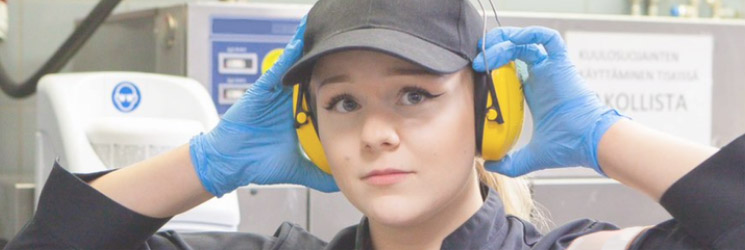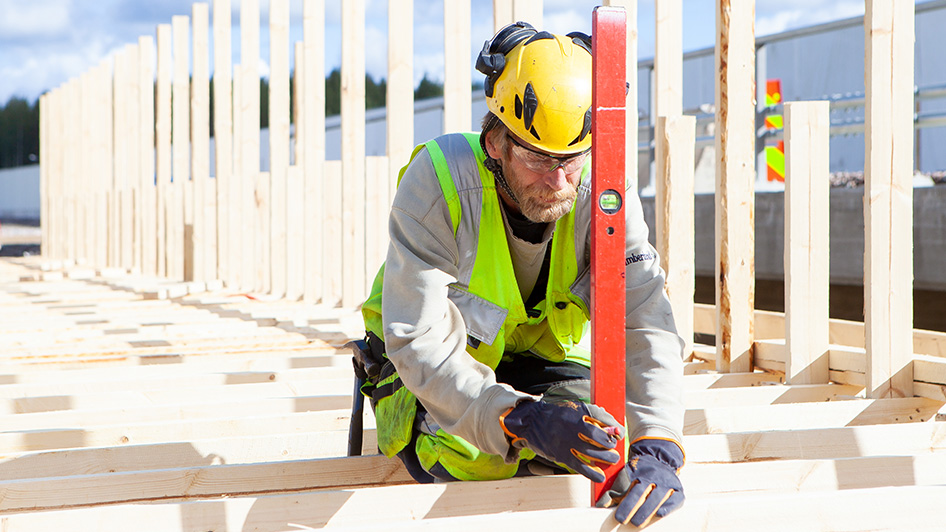

Working conditions
Construction industry
General information on topic
The Occupational Safety and Health Administration works in close cooperation with employers’ and employees’ organisations to ensure occupational safety and health. The authorities also work together to systematically combat unreported employment in the construction industry.
The key aim in monitoring in the construction industry is to reduce the incidence of occupational accidents and work-related diseases and to get employers to comply with their statutory obligations.
Occupational safety must begin at the planning stage
On shared construction sites, it is the developer’s duty to ensure that each of the stages of the build is planned so that the work can be carried out safely and without jeopardising the health of the workers.
The developer must draw up a safety document listing the hazards and risks involved in the construction project and providing information relevant to occupational safety and health. The developer must also ensure that the safety document is kept up to date as the project progresses. Furthermore, the developer must draw up written safety rules and procedures that take into account the nature of the site and explain, among other things, how safety is to be monitored and photo IDs worn on site. Developers’ obligations are set out in sections 5 to 9 of the Government Decree on the Safety of Construction Work (205/2009).
Before building work begins in a construction project, the principal contractor must draw up plans in writing concerning occupational safety and the use of the building site. These plans must then be used to organise the various stages of the building work so as to make them as safe as possible. It must also be ensured that the work causes no hazards for those working on the building site or anyone else affected by the building work.
The principal contractor must present the plans for occupational safety and use of the building site to the developer and keep the plans up to date.
For instance, any lifting and moving to be done on the building site, whether mechanical or manual, must be planned in advance to avoid accidents and personal injury. The machinery and equipment to be used in the work must be carefully selected.
Occupational safety and health managers must be sufficiently qualified
The principal contractor must appoint a person in charge of building site safety for each building site. The duties of that person must be specified in sufficient detail, and his/her employer must ensure that he/she is sufficiently qualified and trained for his/her duties and that he/she has sufficient authority for performing the duties involved.
A site inspection must be performed on a construction site at least once a week for the purpose of investigating and preventing hazards caused by the work or the equipment used. Nowadays, these weekly site inspections are often performed using what is known as the TR barometer. A representative elected by the workers must be allowed to join the inspections.
A construction site is a shared workplace
The term ‘shared workplace’ means a workplace where employees of several employers and/or independent contractors are working simultaneously. Most construction sites have one employer who acts as the project supervisor and therefore has more control and broader responsibilities than the other parties operating on the site, including
- keeping all other employers, their employees and independent contractors up to date on the hazards and risks associated with the site, the safety instructions and procedures to be followed in respect of firefighting, first aid and evacuation, and the identities of the persons responsible for the above,
- coordinating the work of the employers and independent contractors operating on the site,
- organising access to and from as well as within the site,
- keeping the site sufficiently neat and tidy to ensure the workers’ safety and health,
- overseeing the general planning of the site,
- ensuring the overall safety of the working conditions, and
- familiarising new workers with the site.
The project supervisor’s duties cover the entire subcontracting chain, and the project supervisor is therefore responsible not just for the safety of its own staff but also that of all subcontractors’ employees.
More information about the division of responsibilities on construction sites can be found under Construction projects.
Conversely, the other employers and independent contractors on the site must inform the principal employer and other employers of any hazards or risks that their operations may cause on the site. They must also ensure for their part that the work they do will not jeopardise the safety or health of anyone else working on the same site. In addition to this, each employer must look out for his own employees in accordance with the Occupational Safety and Health Act.
Obligations related to combating the black economy
The developer, the principal contractor and each individual employer are responsible for ensuring that everyone who works at the construction site wears a photo ID that also shows the tax number entered for that employee in the tax administration’s tax number register. There must also be a list at the construction site of all workers and independent contractors working on the site. In addition to the above, the provisions of the Act on the Contractor’s Obligations and Liability when Work is Contracted Out apply to the principal contractor and his sub-contractors. If an employer uses foreign labour, the relevant legislation must be complied with, and the terms and conditions of employment for the foreign employees (including pay) must be the same as for everyone employed in Finland.
Photo ID must be required on construction sites
A developer managing or supervising a construction site that is a shared workplace must require, in clauses in the agreements signed or by any other means available, that everyone working on the site carries a photo ID.
The principal contractor or any other party in a similar position must ensure that employees of all employers on the site carry a photo ID that also shows the tax number entered for that employee in the public tax number register.
Employers must ensure that their employees and partners carry photo ID with a tax number and that all employees and partners are entered in the public tax number register.
The only exceptions to the photo ID requirement are persons delivering supplies to the construction site on a temporary basis and persons performing construction or repair work for their own personal use. No photo ID is required for such persons. Also, photo ID is not required on construction sites that are not shared workplaces.
Who must carry a photo ID?
- A photo ID is required for instance for office workers, security guards, cleaners and cement mixer truck drivers working regularly on a construction site.
- By comparison, a delivery truck driver or cement mixer truck driver who only delivers to the site once does not need to have a photo ID.
Who acquires the photo IDs?
- Employers acquire photo IDs for their employees.
- Educational institutions acquire photo IDs for their students.
- Independent contractors acquire their own photo IDs themselves at their own cost.
What does a photo ID need to show?
- Whether the person in question is an employee or an independent contractor.
- If an independent contractor, the photo ID must show the name of his/her business enterprise.
- Name and photo of the employee.
- Name of the employer (wage payer).
- Tax number.
The tax number must exist in the public tax number register. In other words, the number on the photo ID is not a tax number if it is not registered in the tax administration database. This registration may be performed by the employer or by the employee himself/herself. A list of persons working on site and details of the companies operating on site must be available at the construction site.
For further information, see the Finnish Tax Administration website, where the tax number register may also be found.
Instructions for employee
Follow your employer’s instructions concerning safety at work and always wear the prescribed personal protective equipment when working at the construction site. Do not remove any protective components from machinery or equipment. If you notice any shortcomings in safety, talk to your employer and the occupational safety delegate. In addition to managing your own occupational safety, ensure that the work you do does not create a hazard for other people working at the construction site.
Be especially careful when working at locations where there is a danger of falling. Ensure that the ladders, stools, rigs and harnesses you use are in good working order and compliant with regulations.
Asbestos demolition is always extremely hazardous to health, and workers performing it must be specially trained.
Use all machinery and equipment and assistive devices such as handcarts in accordance with the instructions you have been given. Keep the workplace neat and tidy for your part so that using assistive devices to move things around is possible.
Your employer is required by law to monitor employees’ compliance with instructions continuously and to intervene if you do not wear the appropriate personal protective equipment or perform lifts safely.
You must wear a photo ID that also displays your tax number. Your employer must acquire a photo ID for you.Instructions for employer
Your employer must be aware of hazards in the construction industry. Occupational safety is based on risk assessment of the work to be done.
The employer must constantly monitor the working environment, identify any work-related hazards and assess how harmful they are to employees’ health. If the employer does not have sufficient expertise for this, third-party experts such as the occupational health care service must be consulted.
Every employer is required to provide occupational health care for employees. The occupational health care service supports the employer in ensuring safe and healthy working conditions and upholding the work capacity and functional capacity of employees.
Legislation
Occupational Safety and Health Act (738/2002) is applied to all industries. See also for example the following legislation:
Government Decree on the Safe Use and Inspection of Work Equipment (403/2008)
Government Decree on the Safety of Construction Work (205/2009)
Ministry of Labour decision on personnel rooms at construction sites (977/1994) (in Finnish)
Council of State Ordinance concerning safety during blasting and excavation operations (644/2011) (in Finnish)
Charger Act (423/2016) (in Finnish)


